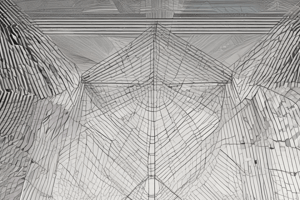Podcast
Questions and Answers
What is orthogonal projection, and how is it different from other types of projections?
What is orthogonal projection, and how is it different from other types of projections?
Orthogonal projection involves representing points from a three-dimensional object onto a two-dimensional plane using perpendicular lines, differing from other projections that may use angled or non-perpendicular lines.
Describe the outcome of projecting a straight line that is parallel to the projection plane.
Describe the outcome of projecting a straight line that is parallel to the projection plane.
The outcome is a line segment that is congruent to the original line and remains parallel to it.
What happens when a straight line is perpendicular to the projection plane?
What happens when a straight line is perpendicular to the projection plane?
The projection results in a single point located at the intersection of the line and the plane.
How does the projection of a straight line that is inclined to the projection plane differ from that of a parallel line?
How does the projection of a straight line that is inclined to the projection plane differ from that of a parallel line?
What steps must be followed to find the projection of a straight line onto a plane?
What steps must be followed to find the projection of a straight line onto a plane?
Explain the importance of orthogonal projection in engineering design.
Explain the importance of orthogonal projection in engineering design.
In what ways is orthogonal projection applied in computer graphics?
In what ways is orthogonal projection applied in computer graphics?
What defines the projection of a point onto a plane?
What defines the projection of a point onto a plane?
Flashcards
Orthogonal Projection
Orthogonal Projection
A method of projecting a 3D object onto a 2D plane by drawing perpendicular lines from each point to the plane.
Straight Line Parallel to Plane
Straight Line Parallel to Plane
Its projection onto the plane is a line segment equal in length and parallel to the original line.
Straight Line Perpendicular to Plane
Straight Line Perpendicular to Plane
Its projection onto the plane is a single point where the line intersects the plane.
Straight Line Inclined to Plane
Straight Line Inclined to Plane
Signup and view all the flashcards
Projection of a point
Projection of a point
Signup and view all the flashcards
Projection of Straight Line
Projection of Straight Line
Signup and view all the flashcards
Engineering Drawings
Engineering Drawings
Signup and view all the flashcards
Computer Graphics
Computer Graphics
Signup and view all the flashcards
Study Notes
Introduction to Projection of Straight Lines
- Projection involves representing a three-dimensional object on a two-dimensional plane.
- For straight lines, this involves projecting their points onto the plane.
- Orthogonal projection, a specific type, uses perpendicular lines to project points from a space onto a plane.
Orthogonal Projection
- Orthogonal projection of a straight line onto a plane is either a line segment, or a point.
- The projection depends on the position and orientation of the straight line relative to the plane.
Cases of Straight Line Projection in Orthogonal Projection
- Case 1: Straight Line Parallel to the Plane: The projection of the line onto the plane is a line segment that is congruent to the original straight line. The projected line is the same length and parallel to the original line.
- Case 2: Straight Line Perpendicular to the Plane: The projection of the line onto the plane is a single point. This point lies on the intersection of the plane and the line.
- Case 3: Straight Line Inclined to the Plane: The projection of the line onto the plane is a line segment that is shorter than the actual length of the line. The line segment is still parallel to the trace of the plane's projection in the plane of projection.
Determining the Projection of Points
- To project a point onto a plane, a perpendicular line is drawn from the point to the plane.
- The intersection of the perpendicular line and the plane is the projected point.
- This process is a key element in determining the entire projected line.
Steps for Finding the Projection of a Straight Line
- Identify the position and orientation of the straight line relative to the plane of projection.
- Determine specific cases based on the parallelism or perpendicularity of the line to the plane.
- Determine the projection of crucial points on the original line.
- Connect the projections of the points to form the projected line.
Importance of Orthogonal Projection
- It is crucial in engineering drawings and design.
- It allows for the accurate representation and understanding of three-dimensional objects on two-dimensional paper or computer screens.
- Provides crucial information regarding length, size, and shape of objects.
Applications in Various Fields
- Engineering design: Used in architectural drawings, mechanical drawings, or civil engineering blueprints.
- Computer graphics: Fundamental in creating realistic images and simulations of 3D objects.
- Mathematics: Used in linear algebra for vector projections and other mathematical concepts.
- Cartography: Used to map geographical features in a two-dimensional plane.
Studying That Suits You
Use AI to generate personalized quizzes and flashcards to suit your learning preferences.




